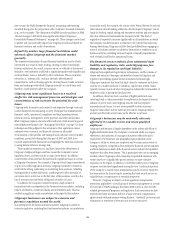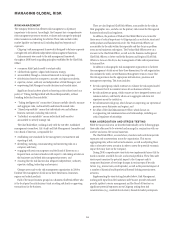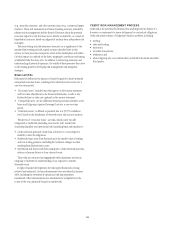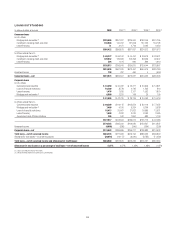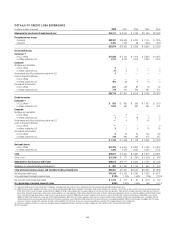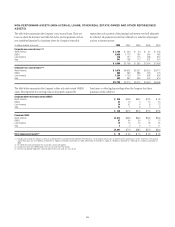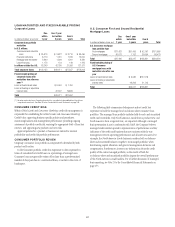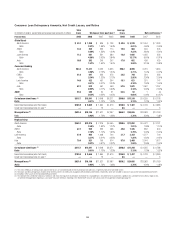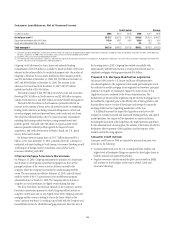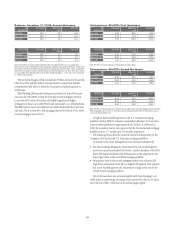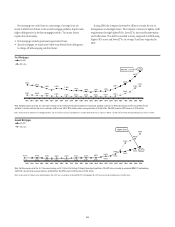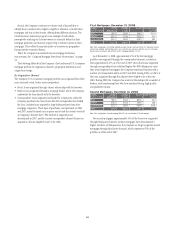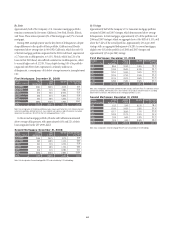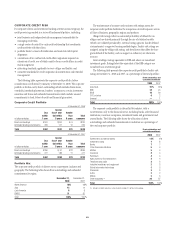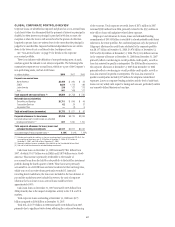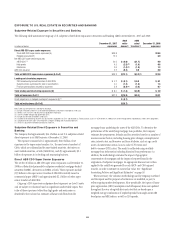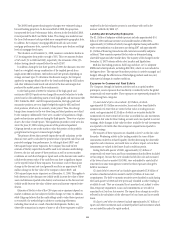Citibank 2008 Annual Report Download - page 65
Download and view the complete annual report
Please find page 65 of the 2008 Citibank annual report below. You can navigate through the pages in the report by either clicking on the pages listed below, or by using the keyword search tool below to find specific information within the annual report.
Consumer Loan Balances, Net of Unearned Income
End of period Average
In billions of dollars 2008 2007 2006 2008 2007 2006
On-balance-sheet (1) $515.7 $557.8 $478.2 $548.8 $516.4 $446.2
Securitized receivables (all in NA Cards) 105.9 108.1 99.6 106.9 98.9 96.4
Credit card receivables held-for-sale (2) —1.0 — 0.5 3.0 0.3
Total managed (3) $621.6 $666.9 $577.8 $656.2 $618.3 $542.9
(1) Total loans and total average loans exclude certain interest and fees on credit cards of approximately $3 billion and $2 billion, respectively, for 2008, $3 billion and $2 billion, respectively, for 2007, and $2 billion and
$3 billion, respectively, for 2006, which are included in Consumer loans on the Consolidated Balance Sheet.
(2) Included in Other assets on the Consolidated Balance Sheet.
(3) This table presents loan information on a held basis and shows the impact of securitization to reconcile to a managed basis. Managed-basis reporting is a non-GAAP measure. Held-basis reporting is the related GAAP
measure. See a discussion of managed-basis reporting on page 57.
Citigroup’s total allowance for loans, leases and unfunded lending
commitments of $30.503 billion is available to absorb probable credit losses
inherent in the entire portfolio. For analytical purposes only, the portion of
Citigroup’s allowance for loan losses attributed to the Consumer portfolio
was $22.366 billion at December 31, 2008, $12.393 billion at December 31,
2007 and $6.006 billion at December 31, 2006. The increase in the
allowance for loan losses from December 31, 2007 of $9.973 billion
included net builds of $11.034 billion.
The builds consisted of $10.785 billion in Global Cards and Consumer
Banking ($8.216 billion in North America and $2.569 billion in regions
outside North America), and $249 million in Global Wealth Management.
The build of $8.216 billion in North America primarily reflected an
increase in the estimate of losses across all portfolios based on weakening
leading credit indicators, including increased delinquencies on first and
second mortgages, unsecured personal loans, credit cards and auto loans.
The build also reflected trends in the U.S. macroeconomic environment,
including the housing market downturn, rising unemployment and
portfolio growth. The build of $2.569 billion in regions outside North
America primarily reflected portfolio growth the impact of recent
acquisitions, and credit deterioration in Mexico, Brazil, the U.K., Spain,
Greece, India and Colombia.
On-balance-sheet consumer loans of $515.7 billion decreased $42.1
billion, or 8%, from December 31, 2007, primarily driven by a decrease in
residential real estate lending in North America Consumer Banking as well
as the impact of foreign currency translation across Global Cards,
Consumer Banking and GWM.
Citigroup Mortgage Foreclosure Moratoriums
On February 13, 2009, Citigroup announced the initiation of a foreclosure
moratorium on all Citigroup-owned first mortgage loans that are the
principal residence of the owner as well as all loans serviced by the
Company where the Company has reached an understanding with the
owner. The moratorium was effective February 12, 2009, and will extend
until the earlier of the U.S. government’s loan modification program
(described below) or March 12, 2009. The Company will not initiate or
complete any new foreclosures on eligible owners during this time.
The above foreclosure moratorium expands on the Company’s current
foreclosure moratorium pursuant to which Citigroup will not initiate or
complete a foreclosure sale on any eligible owner where Citigroup owns the
mortgage and the owner is seeking to stay in the home (which is the
owner’s primary residence), is working in good faith with the Company and
has sufficient income for affordable mortgage payments. Since the start of
the housing crisis in 2007, Citigroup has worked successfully with
approximately 440,000 homeowners to avoid potential foreclosure on
combined mortgages totaling approximately $43 billion.
Proposed U.S. Mortgage Modification Legislation
In January 2009, both the U.S. Senate and House of Representatives
introduced legislation (the Legislation) that would give bankruptcy courts
the authority to modify mortgage loans originated on borrowers’ principal
residences in Chapter 13 bankruptcy. Support for some version of this
Legislation has been endorsed by the Obama Administration. The
modification provisions of the Legislation require that the mortgage loan to
be modified be originated prior to the effective date of the Legislation, and
that the debtor receive a notice of foreclosure and attempt to contact the
mortgage lender/servicer regarding modification of the loan.
It is difficult to project the impact the Legislation may have on the
Company’s consumer secured and unsecured lending portfolio and capital
market positions. Any impact will be dependent on numerous factors,
including the final form of the Legislation, the implementation guidelines
for the Administration’s housing plan, the number of borrowers who file for
bankruptcy after enactment of the Legislation and the response of the
markets and credit rating agencies.
Consumer Credit Outlook
Consumer credit losses in 2009 are expected to increase from prior-year
levels due to the following:
• Continued deterioration in the U.S. housing and labor markets and
higher levels of bankruptcy filings are expected to drive higher losses in
both the secured and unsecured portfolios.
• Negative economic outlook around the globe, most notably in EMEA,
will continue to lead to higher credit costs in Global Cards and
Consumer Banking.
59


